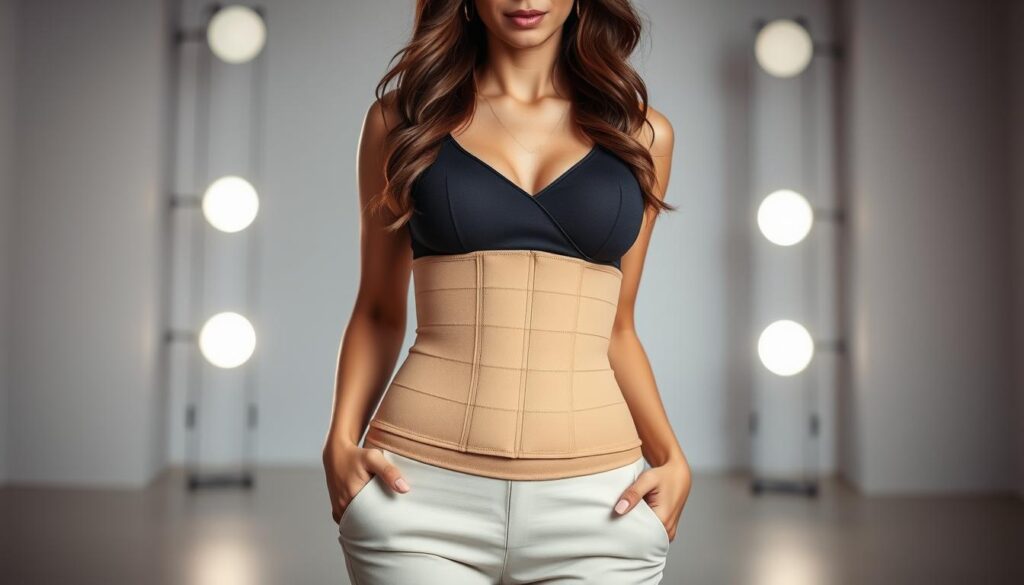Did you know that nearly 68% of women struggle with back fat? They look for ways to shape their bodies. The right waist trainer can change how you look and feel.
Waist cinchers are changing how we shape our bodies. They focus on back fat, providing support and smoothing out trouble spots. This makes you look and feel great.
Today’s waist trainers use advanced technology to target back fat. They help create a more toned body. Knowing how they work helps you choose the best one for you.
Key Takeaways – Best Waist Trainer For Back Fat
- Waist trainers can reduce back fat appearance instantly
- Proper sizing is key for effective back fat compression
- High-quality materials improve body shaping results
- Combining waist training with exercise boosts fat loss
- Vest-style designs offer better back coverage
Understanding Back Fat and Its Causes
Back fat is a common worry for many. Knowing why it happens helps find ways to reduce it.
Common Factors Contributing to Back Fat
Several things can lead to back fat. These are important for how fat is spread:
- Sitting too much and not moving
- Eating too much processed food
- Not exercising the right areas
- Changes in hormones
- Not sleeping enough and feeling stressed
Impact of Posture on Back Fat
Posture correctors are key in fighting back fat. Bad posture can weaken muscles and add fat to the back and waist. Wearing compression and body shaping clothes helps keep muscles right and strong.
Genetic Influences on Body Shape
Genetics shape how fat is spread. While you can’t change your genes, you can manage your body shape. Some people tend to store fat in the back because of their genes.
Research shows it’s hard to lose fat in one spot, so a full fitness plan is best.
Knowing these reasons helps people tackle back fat. They can use diet, exercise, and posture correctors and compression clothes wisely.
Benefits of Using a Waist Trainer
Waist trainers are popular for body shaping and managing back fat. They offer more than looks, helping with body shaping and boosting confidence.
Learning about waist trainers’ benefits can help you decide if they’re right for you. They’re great for fitness and body transformation.
How Waist Trainers Work for Back Fat
Waist trainers target back fat with compression and heat. Their design helps:
- Compress soft tissue around the midsection
- Redirect fat deposits for a smoother silhouette
- Increase perspiration during physical activities
“A properly fitted waist trainer can reduce visible back bulge by creating a more streamlined appearance,” notes fitness expert Dr. Rachel Thompson.
Additional Benefits of Waist Trainers
Waist trainers offer more than just back fat management. They also:
- Improve posture alignment
- Support core muscles
- Reduce waistline temporarily
Postpartum Shapewear is great for new moms. It helps regain confidence and supports the core during recovery.
Safety and Considerations for Use
Waist trainers are safe when used correctly. Experts suggest:
- Wearing for limited hours per day
- Choosing breathable materials
- Maintaining proper sizing
- Combining with regular exercise
Always talk to a healthcare professional before starting any new body shaping regimen. This ensures safety and effectiveness.
Features to Look for in a Waist Trainer
Choosing the right waist trainer is important. About 70% of women worry about back fat. So, finding the right compression garments is key for a smooth look.
When looking at body shaping wear, knowing the important features can really help. It can make a big difference in how comfortable you feel and how well it works.
Material Quality and Comfort
The best waist trainers are made from good materials. Look for ones with Thermal Sweat Technology. It helps you sweat more and might help you lose fat.
- Breathable fabrics for all-day comfort
- Durable latex construction
- Soft inner lining to prevent skin irritation
Design and Fit for Maximum Efficiency
Good design makes a waist trainer work better. Studies show shapewear can make your waist look 2 inches smaller if worn right.
- Adjustable closures for customized fit
- Flexible steel boning for structure
- High-compression zones targeting back fat
“The right waist trainer is like a supportive friend – it helps you look and feel your best.” – Fitness Expert
Ease of Use and Maintenance
A good waist trainer should be easy to use every day. With 40% of people wearing bodysuits daily, it’s all about convenience.
- Machine washable materials
- Quick-drying fabrics
- Simple closure mechanisms
Pro tip: Always follow the care instructions from the maker. It helps keep your waist trainer in good shape for longer.
Top Waist Trainers for Back Fat
Finding the right waist trainer for back fat can change your body shaping journey. The best waist cinchers offer targeted compression and support. They help minimize back bulges and create a smoother silhouette.
Best Options for Back Fat Slimming
When picking a waist trainer for back fat, several key factors matter. Experts say to look at compression level, material quality, and design features that target problem areas.
- Vedette 100 POWERFUL Latex Strapped Underbust Waist Cincher
- Price: $73.00
- Colors: Black and Beige
- Powerful latex compression for back fat control
- Hip Control Latex Waist Trainer
- Thermal activity stimulation
- Enhanced perspiration during workouts
Key Features to Consider
When choosing waist trainers for back fat slimming, look for these critical characteristics:
- Vest-style design that covers bra line completely
- Adjustable compression levels
- Moisture-wicking materials
- Seamless construction to prevent bulging
Price and Value Comparison
The market offers waist trainers at various price points. Budget-conscious users can find effective options between $50-$100. These provide excellent back fat reduction and body shaping capabilities.
Pro Tip: Choose a waist trainer one size larger if between sizes to prevent uncomfortable tissue spillover.
How to Choose the Right Size Waist Trainer
Finding the perfect fit for your compression garments is key for effective body shaping. The right waist trainer can greatly improve your bulge control bands’ performance and comfort.
Choosing the ideal waist trainer needs careful thought and precise measurements. Your body’s unique shape is important for finding the best compression garment.
Measuring Your Waist Accurately
To get the best fit for your body shaping wear, follow these steps:
- Use a soft vinyl or fabric tape measure
- Measure your natural waist at the narrowest point
- Take measurements while standing straight
- Avoid pulling the tape too tight or too loose
Understanding Brand-Specific Size Charts
Different brands have their own sizing systems. The Universal Cup Sizing™ (UCS®) system helps find the perfect fit across brands.
| Waist Size | Recommended Trainer Size | Compression Level |
|---|---|---|
| 24-26 inches | Small | Light |
| 27-29 inches | Medium | Medium |
| 30-32 inches | Large | Firm |
Tips for Trying on Your Waist Trainer
Pro tip: If you’re between sizes, always choose the larger size. A too-tight waist trainer can cause uncomfortable bulging and discomfort.
- Check for smooth lines without visible bulges
- Ensure comfortable breathing and movement
- Verify the trainer sits correctly on your body
- Consider your body’s unique shape and proportions
Remember, finding the perfect waist trainer is a process. Be patient with yourself and prioritize comfort and effectiveness in your body shaping journey.
How to Incorporate a Waist Trainer into Your Routine
Adding a waist trainer to your fitness journey can change your life. These belts do more than look good; they support and motivate your body goals. It’s important to know how to use them right for the best results.

Start slow when you begin waist training. Modern waist trainers use Thermal Sweat Technology to boost your workouts. Here’s how to add a waist trainer to your routine:
- Begin with 1 hour of wear per day
- Increase wear time by 1 hour daily
- Aim for 8-12 hours of total daily wear
- Listen to your body and adjust as needed
Combining Waist Training with Exercise
Working out with a waist trainer makes your exercises better. Core workouts are great. Remember to drink plenty of water while training, as you’ll sweat more with these garments.
Best Exercises for Targeting Back Fat
Choose exercises that match your waist trainer’s design. Focus on exercises that work many muscles and build core strength:
- Cardio intervals
- Planks and side planks
- Resistance band workouts
- Low-impact strength training
Daily Wear Guidelines for Beginners
Being consistent is key with waist trainers. Start slow, watch how your body reacts, and adjust as needed. Having two waist trainers – one for workouts and another for daily use – can help you get the most out of them.
Pro tip: Track your measurements and take progress photos to stay motivated and document your transformation!
Real Customer Reviews and Experiences
Exploring the world of Best Waist Trainer For Back Fat shows a world of personal change. People share amazing stories of their Back Fat Slimming journey. They talk about how Body Shaping Wear has helped them, not just in size.
Positive Impacts Reported by Users
Users have seen big changes with waist trainers. They’ve lost 1 to 10 inches around their waist. This depends on how hard they work and how long they wear it. Here are some amazing stories:
- Lindsey reduced her waist from 29″ to 26″ after 3 years
- Siddeeqah went from a 48″ waist to 38″ in just one year
- Briana decreased her waist from 28″ to 21″ in 8 months
Common Challenges and User Tips
Waist trainers are promising, but users have tips:
- Try different waist trainers to find the best fit
- Test each trainer for at least 7 days
- Wear it regularly for the best results
Expert Perspectives on Waist Training
Fitness experts say waist trainers can improve posture, lessen back pain, and help shape your figure. They stress that results need ongoing effort.
Waist training is a journey of commitment and gradual transformation, not an instant solution.
The best users see waist training as part of a bigger fitness plan. They mix it with good food, exercise, and regular wear for the best outcomes.
Maintenance and Care for Your Waist Trainer
Proper care of your body shaping wear is key to keeping it effective and lasting long. Compression garments need special care to keep giving the support and shape you want.
Looking after your waist trainer is more than just cleaning it now and then. Knowing the right ways to care for it can help you get the most out of it.
Washing Instructions for Optimal Performance
Cleaning your waist trainer needs gentle care. Here are the essential steps:
- Hand wash in cool water with mild detergent
- Avoid harsh chemicals or bleach
- Never use a dryer – air dry flat
- Wash after every 2-3 uses to prevent bacteria buildup
Proper Storage Techniques
How you store your waist cinchers is important for keeping them in shape and elastic:
- Store in a cool, dry place
- Keep away from direct sunlight
- Hang or lay flat to prevent creasing
- Use padded hangers for delicate compression garments
When to Replace Your Waist Trainer
Knowing when to replace your body shaping wear is key for it to keep working well. Look out for these signs:
- Visible stretching or loss of elasticity
- Permanent fabric discoloration
- Torn or damaged fastenings
- Reduced compression performance
Experts say to replace waist trainers every 3-6 months if you use them a lot. Remember, a worn-out waist trainer can’t provide the support you need for your body shaping journey.
Common Myths and Misconceptions

Waist trainers have sparked many debates in the body shaping wear industry. Many people have wrong ideas about their effectiveness for back fat slimming and body transformation. Knowing the truth behind these myths can help you make better choices about compression garments.
Debunking Popular Waist Training Myths
Let’s look at some common myths about waist trainers:
- Myth: Waist trainers guarantee instant weight loss Reality: The first weight loss is mostly from fluid loss through sweat, not fat reduction.
- Myth: Waist trainers permanently reshape your body Research shows that long-term use of body shaping wear can’t make permanent changes without diet and exercise.
- Myth: Waist trainers are completely safe for continuous use Medical experts say that wearing them too much can weaken core muscles and affect breathing.
The Truth About Weight Loss Claims
“Waist trainers are a tool, not a magic solution for weight loss,” says fitness expert Dr. Rachel Thompson.
Some users, like Nissa, have lost weight (7 kg in 2 months). But this was from waist training, regular exercise, and a healthy diet. Compression garments alone can’t lead to significant long-term weight loss.
Comparing Body Shaping Methods
Experts always suggest focusing on lasting ways to slim down your back:
- Balanced nutrition
- Regular cardiovascular exercise
- Strength training
- Consistent physical activity
Understanding these points can help you see waist trainers as a helpful tool, not the only way to transform your body.
Expert Tips for Maximizing Waist Trainer Effectiveness
To get the most out of Sweat Enhancing Belts, you need more than just the belt. Back Fat Slimming works best when you eat right and live healthy. These habits help you reach your body goals.
Your diet is key to getting the most from Thermal Sweat Technology and waist training. What you eat affects how your body shapes and slims.
Nutrition Tips to Complement Your Waist Training
- Focus on lean proteins to support muscle maintenance
- Choose complex carbohydrates for sustained energy
- Incorporate plenty of vegetables for essential nutrients
- Limit processed foods and sugary snacks
Importance of Hydration
Drinking enough water is vital when using Sweat Enhancing Belts. Water helps:
- Support metabolic processes
- Reduce water retention
- Make Thermal Sweat Technology work better
- Keep your body running smoothly
Encouraging Mindful Eating Habits
Mindful eating is a game-changer for Back Fat Slimming. Eat smaller meals, take your time, and listen to your hunger. Keep track of what you eat to understand your nutrition better.
| Eating Habit | Benefit |
|---|---|
| Small, frequent meals | Boosts metabolism |
| Protein-rich breakfast | Reduces morning cravings |
| Mindful portion sizes | Prevents overeating |
Waist training works best when it’s part of a bigger health plan. Stay consistent, be patient, and stay positive to reach your body goals.
Conclusion: Finding the Best Waist Trainer for You
Finding the right waist trainer for back fat needs careful thought and a personal touch. It’s about understanding what you need, whether it’s the Best Waist Trainer for Back Fat or Waist Cinchers for postpartum shapewear.
Your success with waist training comes from consistent effort and smart choices. Start by wearing it for 30-60 minutes and then increase to 8-10 hours. Remember, you won’t see big changes in a week. But, with regular use, you’ll see big results.
Drinking enough water and eating right are key to making your waist trainer work better. Women should drink 2.7 liters a day, and men should drink 3.7 liters. Eat lean proteins, complex carbs, and healthy fats. Also, make sure your waist trainer is comfortable and don’t wear it too tight or for too long.
Your waist training journey is about feeling confident and strong. With patience, the right technique, and the right Postpartum Shapewear, you can reach your body goals. And remember, your health and well-being are the most important things.
FAQ – Best Waist Trainer For Back Fat
What is a waist trainer and how does it help with back fat?
A waist trainer is a tight-fitting garment that shapes your midsection. It helps hide back fat by compressing the waist and back. The best ones use special materials and designs to help lose fat and shape your body.
How long should I wear a waist trainer each day?
Beginners should start with 2-4 hours a day. Experts say not to wear it more than 8 hours. Always listen to your body and make sure it’s comfortable.
Can a waist trainer help me lose back fat permanently?
Waist trainers aren’t a permanent fix for fat loss. They can temporarily hide back fat. But, lasting results come from eating right, exercising, and wearing body shaping wear consistently.
Are waist trainers safe to use during workouts?
Many waist trainers are made for workouts. But, pick a breathable, flexible one. Don’t restrict your movement or breathing. Talk to a fitness expert to use it safely during exercise.
How do I choose the right size waist trainer?
Measure your natural waist and check the brand’s size chart. Choose a trainer that’s firm but not too tight. Some brands offer Universal Cup Sizing™ (UCS®) for a better fit.
Can waist trainers help improve posture?
Yes, many waist trainers help correct your posture. They support your back and promote proper alignment. This can also reduce the look of back fat and provide core support all day.
How often should I wash my waist trainer?
Wash your waist trainer after every 2-3 uses, depending on sweat. Follow the care instructions to keep it effective. Hand washing is best to keep the material in good shape.
Are waist trainers suitable for postpartum women?
Many waist trainers are made for postpartum women. They offer support and compression. But, always check with a healthcare provider before using any body shaping garment after childbirth.
How long does it take to see results from waist training?
Results vary, but most see improvements in 4-8 weeks. Remember, waist training works best with a healthy diet and regular exercise.
Can men use waist trainers for back fat reduction?
Absolutely! Waist trainers and compression garments are for both men and women. Many men use them to target back fat, improve posture, and enhance their physique during workouts and daily activities.










